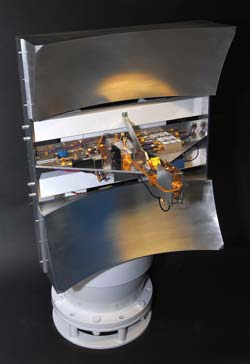Making runways safer

The radar sensor can detect objects just centimeters across on runways. (© Fraunhofer FHR)<br>
It might have happened over ten years ago now, but most people can still recall the Concorde crash: the TV images showing the supersonic jet with flames streaming from its tail were unforgettable. It was a piece of metal lying on the runway during take-off that caused the accident. The aircraft’s tire burst as it rolled over the metal, sending chunks of rubber flying into the fuel tank, which then exploded – with the loss of 113 lives.
To avoid accidents such as this, airport staff drive up and down runways at six-hour intervals looking for any pieces of debris. But to monitor the huge areas in question without any kind of technical assistance is time-consuming and error-prone work – especially in bad weather, for instance when fog is obscuring the view. And the intervals between checks are also too long.
A new weatherproof safety system will in future monitor runways continuously for debris and warn of any dangers. Research scientists at the Fraunhofer Institutes for High Frequency Physics and Radar Techniques FHR and for Communication, Information Processing and Ergonomics FKIE are developing the system in conjunction with the University of Siegen, PMD Technologies GmbH and Wilhelm Winter GmbH in a project dubbed LaotSe – short for “Airport runway monitoring through multimodal networked sensor systems.“ “Our technology would have prevented the Concorde tragedy from happening,” says Dr. Helmut Essen, who heads the Millimeter-Wave Radar and High Frequency Sensors department at the FHR in Wachtberg. “Devices installed all along the runway continuously scan the surface. They can detect even the smallest of items, such as screws, but the system will only issue a warning if an object remains on the runway for a longer period of time. A windblown plastic bag or a bird resting briefly will not set off the alarm.”
The system comprises an infrared camera, optical 2D and 3D cameras and networked radar sensors. These sensors were developed by researchers at the FHR. The three different types of equipment complement each other: Radar functions around the clock and whatever the weather. It can detect objects but not identify them. The cameras are better suited to classifying objects, but they are affected by the weather and the time of day. Whenever a radar sensor detects something, it instructs the cameras to take a closer look. All the sensor data are then amalgamated using software developed at the FKIE to produce a situational overview. The FKIE experts call this ‘sensor data fusion’. If the overview shows an abnormal situation, air traffic control is informed in the tower. They can take a look at their screens to judge whether there is a real danger and, if so, halt air traffic. “Our solution is merely an assistance system. The final decision on how to proceed lies with airport staff,” stresses Dr. Wolfgang Koch, head of department at the FKIE.
While similar radar systems have been developed, these are only capable of detecting metal objects, and they often give rise to false alarms. What is more, because they are mounted high up on masts they can easily be damaged in the event of an airplane accident. Dr. Essen outlines some of the new system’s advantages: “Our radar sensor transmits at a frequency of 200 GHz, so it can detect objects that are just one or two centimeters across. And using three different kinds of sensor means false alarms are almost out of the question. The device is miniaturized and scans up to 700 meters in all directions.” Initial testing of a radar sensor and camera will begin at Cologne-Bonn airport this fall, and plans are in place for further testing using several demonstrator systems before the project ends in April 2012.
Media Contact
All latest news from the category: Physics and Astronomy
This area deals with the fundamental laws and building blocks of nature and how they interact, the properties and the behavior of matter, and research into space and time and their structures.
innovations-report provides in-depth reports and articles on subjects such as astrophysics, laser technologies, nuclear, quantum, particle and solid-state physics, nanotechnologies, planetary research and findings (Mars, Venus) and developments related to the Hubble Telescope.
Newest articles

High-energy-density aqueous battery based on halogen multi-electron transfer
Traditional non-aqueous lithium-ion batteries have a high energy density, but their safety is compromised due to the flammable organic electrolytes they utilize. Aqueous batteries use water as the solvent for…

First-ever combined heart pump and pig kidney transplant
…gives new hope to patient with terminal illness. Surgeons at NYU Langone Health performed the first-ever combined mechanical heart pump and gene-edited pig kidney transplant surgery in a 54-year-old woman…

Biophysics: Testing how well biomarkers work
LMU researchers have developed a method to determine how reliably target proteins can be labeled using super-resolution fluorescence microscopy. Modern microscopy techniques make it possible to examine the inner workings…





















